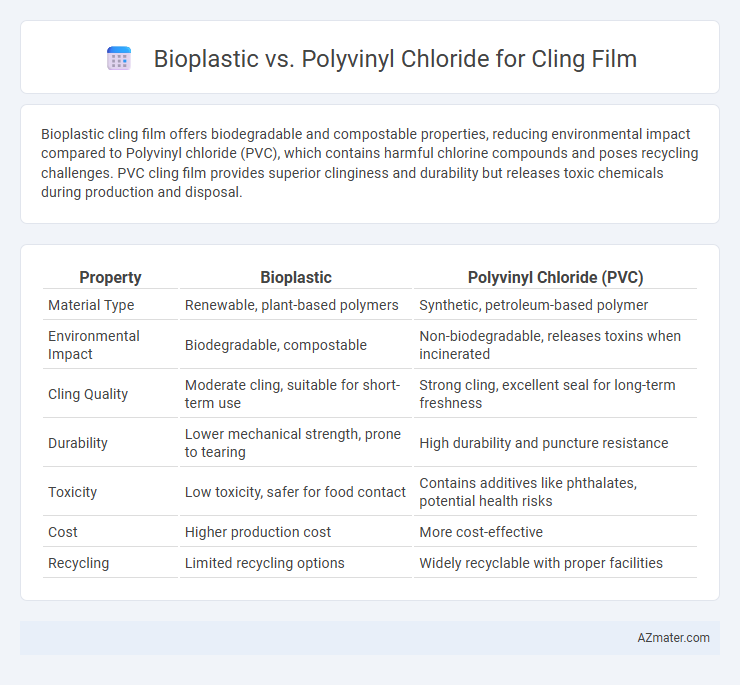Bioplastic cling film offers biodegradable and compostable properties, reducing environmental impact compared to Polyvinyl chloride (PVC), which contains harmful chlorine compounds and poses recycling challenges. PVC cling film provides superior clinginess and durability but releases toxic chemicals during production and disposal.
Table of Comparison
| Property | Bioplastic | Polyvinyl Chloride (PVC) |
|---|---|---|
| Material Type | Renewable, plant-based polymers | Synthetic, petroleum-based polymer |
| Environmental Impact | Biodegradable, compostable | Non-biodegradable, releases toxins when incinerated |
| Cling Quality | Moderate cling, suitable for short-term use | Strong cling, excellent seal for long-term freshness |
| Durability | Lower mechanical strength, prone to tearing | High durability and puncture resistance |
| Toxicity | Low toxicity, safer for food contact | Contains additives like phthalates, potential health risks |
| Cost | Higher production cost | More cost-effective |
| Recycling | Limited recycling options | Widely recyclable with proper facilities |
Introduction to Cling Film Materials
Cling film materials primarily include bioplastics and polyvinyl chloride (PVC), each offering unique properties for food packaging. Bioplastics, derived from renewable sources like cornstarch or sugarcane, provide biodegradable and compostable alternatives with lower environmental impact. Polyvinyl chloride, a petroleum-based polymer, offers superior elasticity and durability but raises concerns due to its non-biodegradability and potential release of harmful chemicals during production and disposal.
What is Bioplastic Cling Film?
Bioplastic cling film is made from renewable plant-based materials such as cornstarch or sugarcane, offering a sustainable alternative to traditional plastic wraps. Unlike polyvinyl chloride (PVC) cling film, bioplastic film is biodegradable and compostable, reducing environmental impact and plastic waste. Its natural composition provides similar cling and stretch properties while minimizing the release of harmful chemicals during production and disposal.
Overview of Polyvinyl Chloride (PVC) Cling Film
Polyvinyl chloride (PVC) cling film is widely used for food packaging due to its excellent clarity, stretchability, and strong barrier properties that help preserve freshness. PVC cling film is resistant to punctures and tears, making it ideal for tightly wrapping irregularly shaped items while maintaining airtight protection. Despite its advantages, concerns over environmental impact and potential chemical leaching have driven the search for more sustainable alternatives like bioplastics.
Material Composition and Safety
Bioplastic cling films are primarily derived from renewable resources such as cornstarch or sugarcane, offering biodegradable properties and reduced environmental impact compared to polyvinyl chloride (PVC), which is a petroleum-based synthetic polymer. PVC cling films often contain plasticizers like phthalates that can migrate into food, raising health concerns, whereas bioplastics generally avoid such additives and are considered safer for food contact. The material composition of bioplastics supports compostability and lower toxicity, making them a safer alternative to PVC in terms of food safety and environmental sustainability.
Environmental Impact: Bioplastic vs PVC
Bioplastic cling films significantly reduce environmental impact due to their biodegradable and compostable properties, minimizing long-term waste accumulation and reducing reliance on fossil fuels. In contrast, polyvinyl chloride (PVC) cling films release harmful additives and dioxins during production and disposal, contributing to soil and water pollution and persistent environmental toxicity. Life cycle assessments indicate bioplastic films offer lower carbon footprints and enhanced sustainability compared to conventional PVC alternatives in food packaging.
Performance and Usability Comparison
Bioplastic cling films, primarily made from PLA or starch-based polymers, offer superior biodegradability and a lower carbon footprint compared to conventional Polyvinyl Chloride (PVC) films, which are known for their excellent tensile strength and moisture barrier properties. PVC cling films provide higher clinginess, durability, and resistance to stretching, making them better suited for long-term food preservation and industrial applications, whereas bioplastic films often struggle with lower mechanical strength and shorter shelf life. Usability differences highlight that PVC films maintain performance in diverse temperature ranges, while bioplastic alternatives are more sensitive to heat and require optimization to match the flexibility and sealing capabilities of traditional PVC cling films.
Food Safety and Chemical Migration
Bioplastic cling films, made from renewable resources like polylactic acid (PLA) or starch-based polymers, offer superior food safety by minimizing harmful chemical migration compared to polyvinyl chloride (PVC) films, which can release residual plasticizers such as phthalates and vinyl chloride monomers. Studies indicate that PVC cling films may pose health risks due to potential leaching of endocrine-disrupting compounds, especially when in contact with fatty or heated foods. Bioplastics provide a safer barrier with lower migration levels under various storage conditions, enhancing consumer protection and compliance with stringent food contact regulations.
Cost Analysis and Market Availability
Bioplastic cling films generally have higher production costs compared to polyvinyl chloride (PVC) films due to the raw materials and manufacturing processes involved, which impacts their price competitiveness. PVC cling films dominate the market with widespread availability, benefiting from established supply chains and lower material costs. The growing demand for sustainable alternatives is gradually expanding bioplastic presence in niche segments despite its limited market share and higher price point.
Consumer Preferences and Industry Trends
Bioplastic cling films are gaining consumer preference due to their biodegradability and reduced environmental impact compared to polyvinyl chloride (PVC), which remains popular for its durability and cost-effectiveness. Industry trends show a strong shift towards sustainable packaging solutions, with major manufacturers investing in bioplastic technologies to meet increasing regulatory pressures and eco-conscious market demands. Despite this, PVC cling film continues to be widely used in commercial food packaging where barrier properties and price competitiveness are critical factors.
Future Outlook: Innovations in Cling Film Materials
Bioplastic cling films are advancing with enhanced biodegradability and compostability, addressing environmental concerns linked to traditional polyvinyl chloride (PVC) films, which release harmful dioxins during disposal. Innovations in bio-polymer blends and nanocomposite additives are improving the mechanical strength and barrier properties of bioplastic films, making them viable alternatives to PVC in food packaging. Future developments focus on scalable production technologies and circular economy integration to reduce plastic pollution and enhance sustainability in cling film applications.

Infographic: Bioplastic vs Polyvinyl chloride for Cling film
 azmater.com
azmater.com